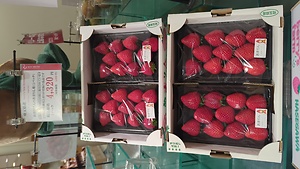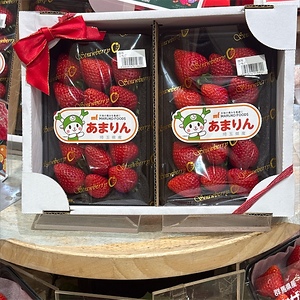


Amarin Strawberries
Estimated Inventory, lb : 0
Description/Taste
Amarin strawberries vary in size and shape, depending on cultivation, and are generally a medium to large varietal in Japan. The fruits have a short, conical, to cordate shape with sloping shoulders tapering to a slightly pointed, curved tip. The variety is also topped with flat leaves that extend over the fruit’s shoulders. These leaves should be green and fresh when sold in markets. Amarin strawberries have dark red, saturated hues and smooth, taut, and glossy skin. The skin is embedded with golden brown specks resembling seeds known as achenes. Underneath the surface, the red-to-white flesh showcases varying degrees of color, with some fruits being completely red inside while others may have a white core. The fruit’s center may also feature a tiny hollow cavity. Amarin strawberries have a semi-firm consistency combined with an aqueous, succulent, plump, and tender mouthfeel. The variety also has a slightly crisp texture due to the exterior achenes. When ripe, Amarin strawberries are edible raw and release an aromatic, sweet, and fruity aroma. The variety is known for its high sugar content, ranging from 18 to 20 degrees Brix, which is notable as other common commercial cultivars average around 10 degrees Brix. This high sugar content, mixed with low acidity, creates a sweet, subtly tart, tangy, fruity taste.
Seasons/Availability
Amarin strawberries are available in Japan from winter through spring, with a peak season between mid-January and early April.
Current Facts
Amarin strawberries, botanically classified as Fragaria ananassa, are a Japanese varietal belonging to the Rosaceae family. The cultivar was selectively bred in the early 21st century as a new strawberry unique to the Saitama Prefecture, initially known under the name Saien No.3, sometimes written as Saitamaen No. 3. Amarin strawberries were chosen for their sweet and subtly sour taste, vibrant coloring, and aroma. The variety is considered easy to eat, not needing additional accompaniments, and was developed to attract and increase agricultural tourism to the prefecture. Since their release, Amarin strawberries are a protected variety only approved for cultivation in the Saitama Prefecture. The cultivar is sold as a premium strawberry and is grown in limited quantities, making it challenging to find in markets. Despite their rarity, Amarin strawberries are an anticipated seasonal delicacy and are primarily enjoyed fresh or incorporated into sweet desserts.
Nutritional Value
Amarin strawberries have not been extensively studied for their nutritional properties. Strawberries, in general, are a source of potassium to balance fluid levels within the body and fiber to stimulate and cleanse the digestive tract. Strawberries also provide vitamins A, C, E, and K to maintain healthy organs, strengthen the immune system, guard the cells against the damage caused by free radicals, and aid in faster wound healing. Additional nutrients include calcium, phosphorus, magnesium, and folate. Calcium and phosphorus support bones and teeth, magnesium controls nerve functions, and folate helps the body produce tissues. Strawberries also contain lower amounts of minerals like iron, manganese, copper, and zinc. The red coloring within the fruits indicates the presence of anthocyanins, pigments with antioxidant properties to reduce inflammation and protect the body’s overall health.
Applications
Amarin strawberries have a sweet, subtly sour flavor suited for fresh and cooked preparations. The variety is primarily eaten out of hand and is enjoyed as a stand-alone snack. Japanese consumers believe that the sweetest part of the strawberry is the tip of the fruit. Some choose to eat the fruit in sections, beginning with the flesh surrounding the stem, moving to the center, and finally, the tip of the fruit to taste the progression of sweetness. Beyond eating the fruits whole, Amarin strawberries are sliced and added to fruit medleys, tossed into green salads, or used as a topping over parfaits, crepes, and custards. They are also layered into whipped cream sandwiches, a favorite on-the-go snack in Japan, or used as an edible decoration on tarts or cakes. Try simmering Amarin strawberries into homemade jams, compotes, or syrups. The variety is also wrapped in a soft rice cake with red bean paste, a popular dessert in Japan called ichigo daifuku. Other typical strawberry-centric desserts include shortcakes, sponge cakes, and cookies. Amarin strawberries pair well with chocolate, vanilla, caramel, fruits such as berries, peaches, melon, and mangos, and herbs including basil, mint, thyme, and lavender. Whole, unwashed Amarin strawberries should be immediately consumed for the best quality and flavor. The fruits will also last a few days when stored in a ventilated container or perforated bag in the refrigerator’s crisper drawer.
Ethnic/Cultural Info
Amarin strawberries acquired its retail commercial name from Taihei Hayashiya, a well-known rakugo master. Rakugo is a traditional form of storytelling in Japan that dates back to the Edo Period. The variety’s actual name is Saien No. 3, but Amarin was given to the fruits as a commercial name for increased consumer appeal in markets. Taihei Hayashiya is from the Saitama Prefecture, the same prefecture where Amarin strawberries were created, and is considered the godfather of the variety. When Amarin strawberries were released commercially, another strawberry cultivar called Kaorin also debuted. Both varieties were named by Taihei Hayashiya, and the storytelling artist designed cartoon mascots for the fruits. Images of these mascots can only be used by approved professionals within the Saitama Prefecture. Amarin strawberries are also famous for their achievements at the National Strawberry Championships in Japan, sponsored by the Japan Vegetable Sommelier Association. The annual competition has been held since 2023, and each year, Amarin strawberries have taken first place and won the highest gold award. In 2025, the National Strawberry Championships evaluated 375 strawberries from across Japan, and vegetable sommeliers tasted each entry to evaluate and rank each type.
Geography/History
Amarin strawberries are native to Japan and were developed in the early 21st century as a commercial cultivar unique to the Saitama Prefecture. The variety was mainly developed by breeder Mr. Oda through the Saitama Prefectural Agricultural Technology Research Center in Kumagaya City. Amarin strawberries were developed from a cross between Fukuharuka strawberries, the pollen parent from the Fukushima Prefecture, and Yayoihime strawberries, the seed parent from the Gunma Prefecture. It is said the initial crosses were made in 2008 and 2009, and breeders spent over eight years evaluating and perfecting the variety before its commercial release in 2016. Amarin strawberries were registered in 2019 under the number 27266 and were positioned as a prefecture-specific variety to attract visitors to strawberry agrotourism farms throughout Saitama. Today, Amarin strawberries are grown in greenhouses in the Saitama Prefecture and are seasonally sold through farmstands, supermarkets, online retailers, and high-end department stores. The variety is also shipped to select stores in Tokyo.









